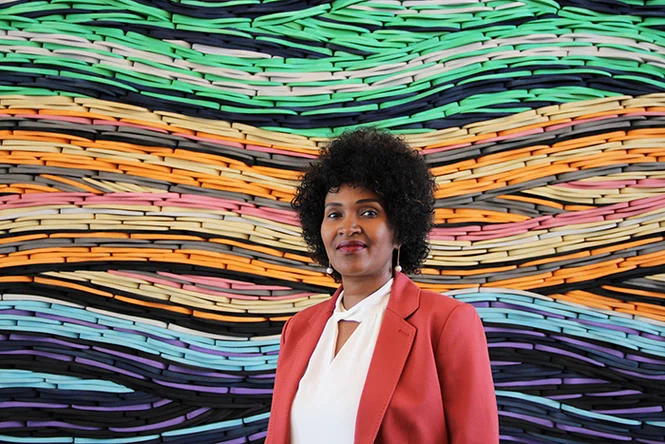
Seconde Nimenya is an author, inspirational speaker and a diversity advocate. For more about her work, visit:
www.SecondeNimenya.com
.Nimenya talks on the power of books and female leaders
October 7, 2019
Today, Seconde Nimenya has two bachelor’s degrees, an MBA, and is an award-winning author. But growing up in Africa, she never even saw a book until she was in the sixth grade. Nimenya shares her story in her memoir “Evolving Through Adversity” and with audiences around the world during speaking engagements focused on diversity and leadership.
EdCal sat down with Nimenya during the Women in School Leadership Forum to ask about being a female leader and what schools can do to increase diversity education.
Q: In learning your story, one word comes to mind and that is resilience. Do you think resilience is something you can teach in schools, or is it something that grows from experiences?
A: You know, you can do both. You can teach resilience skills, especially to young people so they are prepared for life’s adversities, because they are going to come. What I usually do in schools or with young people is what I call “building your resilience tank.” So when those challenges hit you can go back to that tank and use the life skills you’ve learned.
Q: This year, you released a young reader’s edition of your memoir entitled “A Long Way to School.” Why did you want to reach an audience of middle and high school readers?
A: Each time I was doing a presentation, I’d meet some moms or teachers in middle school or high school who say, “Seconde, we love your work for adults — what have you done for kids? We need something similar for our kids.” So that idea came from a middle school teacher. I wrote “A Long Way to School” as a young reader’s edition because I realize, especially middle school years — they’re rough. So that’s why I share that book to inspire and empower young kids, and also share my story — it’s something [kids] can learn from, but can also [help them] realize the world is big outside of their four walls of wherever they live.
Q: I was curious as someone who didn’t have access to books as a child, did you make sure your children had an abundance of books growing up?
A: Yes ma’am! Whether they wanted to read them or not — there were books! As soon as my kids were able to read, I would take them to the library or my favorite bookstore. … My son loved the series “Diary of a Wimpy Kid.” Books make you smart, you know. You learn new words and you learn new worlds, and you get to go to different places you’d probably never go in real life. Books help you develop your imagination and dream big dreams!
Q: This is a women’s leadership conference, and I’m curious what your experience has been in feeling valued as a female leader, especially considering the intersectionality of being a woman of color and an immigrant.
A: I will tell you, it’s not easy to be a female leader – period, because female leaders have to face a lot of hurdles. I mean, women started voting, what, in 1920? And we are still fighting for a place to be seen, to be heard and to lead to the fullest. Being a woman of color and an immigrant on top of that, there are even more hurdles that you have to face. You’re always left feeling like you have to prove yourself, fight for yourself and your community as well.
Q: Do you think men and women lead differently? How?
A: Absolutely, I think so. Some people might be on the outliers, some women and some men as well. But in general, women — we lead from the heart. We feel first before we act on the solution we envision, and that’s being empathetic. Women want to know how the decision they’re making is going to feel? And who is it going to affect? Men, I think, usually lead from the head, they want to fix problems and are more task-oriented — and that’s a good thing. And that is why we need women on all levels of management and leadership. We can solve problems and make the world a better place by using our differences.
Q: What is one piece of advice you would give a struggling female leader?
A: Especially at this conference, I know some women may be leading schools or districts that are struggling. So, what I would say first identify the source of your struggles and identify your strengths. And then, see where your strengths and talents fit in solving those struggles, because you can’t change what you don’t know.
Q: In addition to writing and speaking, you also work with schools to do cultural competency work. Can you describe how you do this and what some of the results have been?
A: A teacher is there to teach everybody, not only the people who look like him or her. Sometimes kids can only identify with people who look like them. So, I try to bring this perspective to schools to let them know we need to expand the fiber of our society, and bring in people of all backgrounds. The outcome has been really wonderful, because I’ve had school principals say, we like your way of seeing things Seconde. Sometimes, you need some outside perspectives and voices to help you shape your goals and see the bigger picture.


